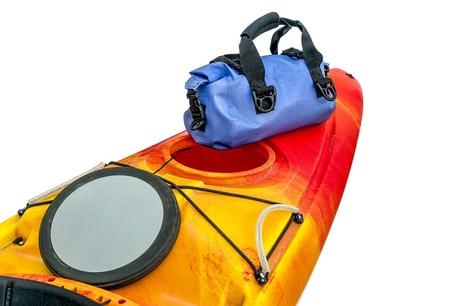
If you love kayaking, then you must admit that one of the hardest things you have ever had to do is keep your stuff dry when you are on the water. Whether that is for a few hours or days, it is important that your gear remains dry, especially since the hatches in most kayaks are not completely dry.
While zip lock bags and plastic-wrapped contraptions might seem like an alternative, they aren’t as effective and most of the time, your stuff will still be damp at the end of the day and that’s where dry bags come in.
By packing your gear into dry bags and stowing it in the hatch, your clean clothes, cellphones, batteries, food and even sleeping bags will not get soggy by the time you are reaching your destination.
What Is a Dry Bag for Kayaking
Fishing from a kayak is quite enjoyable, but at the end of the end it all, the challenge has always been how to keep your gear dry for the entire duration of your fishing trip.
Dry bags are waterproof storage bags that are cylindrical in shape and come in a range of sizes, materials, and waterproofing that is meant to suit different uses. When you are choosing a dry bag, it is important for you to consider what you will pack into it and the kind of conditions you might encounter.
For those who love kayaking and other water sports, the invention of dry bags has been a game-changer and it has become an important piece of equipment that you need to keep your gear protected from the elements.
This ability to seal all your valuables in a waterproof bag means that you can enjoy kayaking without worrying about your stuff getting damp or soggy.
However, just like with any other product like a cordless electric fillet knife, not all dry bags you find on the market are the same. There are some that are of a higher quality, which is what you should be aiming for.
Benefits of Using a Dry Bag for Kayaking
Regardless of where you are kayaking, whether on a calm, scenic lake, a leisurely paddle or in challenging rapids, you need to keep your items dry at the end.
Just like baitcasting reel for saltwater has to be resistant to corrosion to give you value for your money, there are certain benefits of a dry bag that are often overlooked.
Valuable stuff Don’t Get Wet
This is the most obvious and probably the main reason why anyone would buy a dry bag. The mistake that most beginners make is to forego dry bags if their boats have dry compartments.
While a dry compartment can do, at the end of the day, a dry bag is sufficient in keeping your gear with you as well as out of the way when you are kayaking.
Protection From the Sun
A lot of us underestimate the power the sun has when it comes to not only our skin but gear. While you may wear sunscreen when you are kayaking, your gear also needs to be protected against the harmful UV rays.
Contrary to popular belief, the UV rays of the sun can wreak havoc on your gear when you are on the water even during overcast days. A dry bag will protect your items like safety gear and electronics from degrading when exposed to the sun.
Keeps Things Safe and Accessible
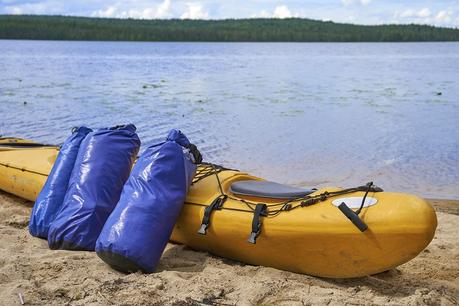
Most dry bags have different attachment systems that are meant to keep your stuff not only secure but reachable when you are paddling. As such, go for a dry bag that is not only waterproof but one that rolls down and buckles.
Float on the Surface
Besides keeping your gear and clothes dry, some dry bags are designed to float on the surface when they have been packed correctly. This makes it very easy to recover your items in case you end up capsizing. Additionally, you can use the dry bag as a makeshift float in an emergency.
Easy to Spot
Dry bags come in bright colors that are easy to spot when floating on the water. They are also light in weight, which will come in handy when you are loading up the kayak.
How Does a Dry Bag for Kayaking Work
Have you ever wondered how you can manage to keep your clothes and phone from getting wet when you are hiking, kayaking or on any other outdoor adventure?
Ziplocs have always been the go-to bags when you want to keep your phone or cash dry when you are outdoors. But what happens when you need to protect more items like your clothes and food?
Putting them in different Ziplocs can be inconveniencing and, not to mention, there is no guarantee that your items will even remain dry. What you need in such a case is a dry bag, but how do these bags work?
A dry bag is usually a container that is in the form of a bag that is designed to keep your sensitive things dry.
Dry bags are made from nylon or vinyl, materials that are usually 100 percent waterproof. They are made of water-resistant fabric, plastic or even plastic-covered fabric that is designed in such a way that it will be water impermeable.
Additionally, a dry bag has a roll-top cover that is either folded three times or rolled to ensure a watertight seal when you are kayaking and is usually made by welding, gluing or sewing.
Dry Bag for Kayaking Materials
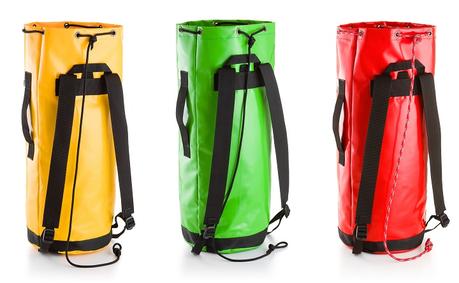
Whether you are using a recreational kayak that offers more control in rough waters or an abrasion-resistant inflatable kayak, a dry bag is a must-have if you are to keep your valuables dry. Dry bags are usually made of different materials, all meant to be water-resistant.
Nylon
This is one of the common materials used to make dry bags for kayaking. Compared to vinyl, coated nylon is lighter, which makes it an ideal companion for campers and backpackers.
Since nylon is not entirely waterproof, the one used to make dry bags is coated with silicone or a thin plastic so as to ensure that water doesn’t get in. Despite this, however, its waterproofing quality is nothing compared to vinyl.
Vinyl
Vinyl is thicker, tougher and is way more waterproof than nylon. It also has a grippy exterior, which means that the bag is easy to grab even when it’s wet.
Vinyl is also easy to maintain in that you can easily patch and repair the bag on your own when it gets damaged.
Polyurethane
This is another material that is used to make dry bags. Polyurethane is usually water-resistant and is used as a protective layer on hardwood and now dry bags, but the material is not entirely waterproof.
PVC
If you are looking for a strong dry bag, then go for one made of PVC. PVC is known to be very tough, but due to the welded seams and high density, such a bag can prove heavier hence not ideal for backpackers or campers.
It is, however, used in extreme sports since it can withstand force and pressure.
Tarpaulin
Tarpaulin is usually a strong and flexible material that comes as a cloth-like canvas or polyester coated with polyurethane.
It is used to make dry bags since it is both water-resistant and waterproof; hence your gear will never get wet when you go kayaking in a tandem kayak, for instance.
How to Choose the Best Dry Bag for Kayaking
If you know what you are looking for, finding a quality dry bag is not that hard. Here are a few factors that you need to consider so as to ensure that you get a bag that meets all your needs and is durable.
Shape
A majority of dry bags are usually cylindrical in shape with an opening at one end. However, you could also get a tapered dry bag which is shaped to fit into the kayak nose.
Also available on the market are holdall dry bags that are usually shaped like duffle bags, which makes it easier to access your things.
Such bags are great to be placed on top of the kayak if you need yours for a longer expedition. They, however, don’t pack efficiently into kayak hatches, which is something you need to be aware of before you make a purchase.
Wearability
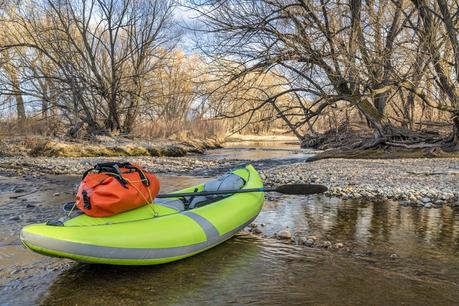
Some people prefer dry bags that they can wear easily, but there are those who prefer straps. For most kayakers, simple drawstrings will work just fine.
However, if you are a paddler who also goes on hikes, then a wearable bag will come in handy. Dry bags that have waist straps are also ideal for hikers and campers.
Visible On and Off the Water
Most kayaking dry bags come in pastels or neons. There are others that have a natural brown or black tone.
It will be in your best interest to buy a brightly colored bag in case you ever lose it when you are on the water. A bright bag will be much easier to track down than the brown or black ones.
It is also recommended that you buy a bag that has reflectors. This will make the bag more visible in low light conditions and also makes it easy for you to be seen by other kayakers.
Materials
The materials that are used to make dry bags for kayaking vary in terms of flexibility, weight, and durability. The most durable bags are the ones that are made from vinyl.
While vinyl is heavy and stiffer, it stands up well to elements and has excellent waterproof capabilities and will come in handy when you want to carry heavy and abrasive items.
Waterproofed nylon, on the other hand, is light in weight but not as durable as vinyl. It is, however, more flexible and is great for packing in very tight spaces or putting in a larger bag.
Such bags are, however, not the best for submersion since they are likely to go underwater, but they are still great for kayaking.
Weight
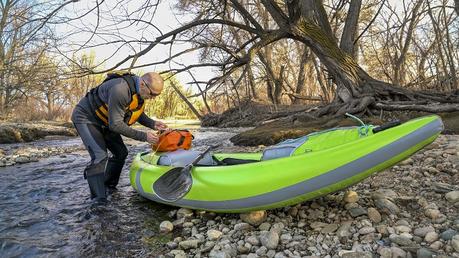
This can be tied to the point above. A majority of dry bags for kayaking are usually light in weight. However, that is not to say that there aren’t those that are heavy.
When you are shopping for a dry bag, consider the weight of the bag itself before you put any items in it. The last thing you need is a bag that is too heavy, especially if you also do backpacking and hiking.
Gear Capacity
Knowing the gear capacity that you will be taking with you will help you decide on the dry bag that will meet your needs.
Most manufacturers will have indicated the cubic inch and liter capacities on the description. Even so, the most important thing that you need to consider is the liter capacitor than the cubic inches.
Submersible or Not
When kayaking, how often do you get submerged underwater? This is an important factor to consider because it will determine the bag you get.
If you get submerged quite often, then you need a dry bag that can still keep your belongings dry when that happens.
Such bags come with a lock and open seal openings so that you can suck the air out of them. Bags that are not designed to be submerged underwater will often have a zipper or nylon drawstrings.
Style of Bag
The style of the bag is all a matter of personal preference, as well as convenience. That said, there are bags that have only a single strap that is worn across your body or on your shoulder.
There are also dry bags that have shoulder straps such that they can be worn like backpacks. Such bags will come in handy if you are traveling long distances on foot or have a heavier or larger bag.
For campers, a dry bag that can double up as a backpack is ideal since it frees up your hands to carry other gear.
Colors
While you may want a bag in your favorite color, when it comes to dry bags, the color of the bag makes a difference. With that in mind, it would be in your best interest to consider just how visible you will be in case of an emergency.
Brighter colors tend to be more noticeable both on and off the water and will help you get located in case you encounter difficulties when on the water. A brightly colored dry bag is also easier to locate if it falls overboard than the black or brown ones.
Size
The size of the bag will depend on what you intend to use it for. Just like traditional backpacks, dry bags for kayaking are measured in terms of the liters, in which case, the higher the volume, the more gear the bag can hold.
If you want a bag to keep a few essentials like clothes, wallet, and phone dry for a couple of hours, then a 10-liter bag will do. If you are going on longer trips, then consider bags that have a liter capacity of between 30 and 40.
At the same time, if you are planning an extended trip on a canoe or kayak, it is recommended that you take with you more than one dry bag.
This will allow you to keep camping gear, clothing, and food dry for the entire duration of the trip.
Durability
Just like with a premium kayak paddle, the durability of the dry bag will help you get value for your money. In such a case, consider the materials used to make the bag. Bags made of vinyl are more durable than those made of plastic or any other material.
Closure
When it comes to closure, there are two types that are used to seal the tops of dry bags; zipper seals and roll tops. Roll tops are usually sealed by folding the top of the closure a few times and clipping the two ends.
Such closures offer better waterproofing capabilities and not to mention the clipped buckle can also double up as a handle.
Zipper seals resemble the seals on Ziploc bags, but they are larger and way more durable. They are, however, not as waterproof as roll tops since the seal can break hence the reason why you need to double-check the zipper seal before you get on the water.
There are dry bags that make use of both types of seals providing excellent foolproof waterproofing.
Shoulder or Handle
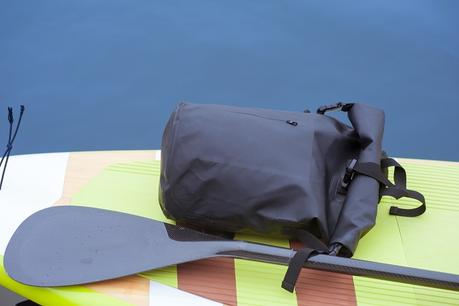
There are people who prefer carrying their dry bags with just the shoulder strap, while others prefer them as backpacks. Normally, smaller bags will often come with a shoulder strap that can be adjusted to fit the preference of the user.
Bigger bags, on the other hand, have two shoulder straps so that you can wear them as backpacks.
There are smaller bags, however, that come with two shoulder straps. Whatever bag you get will depend on what you are going to use it for and how long you will be gone.
Campers and backpackers are better off with the dry bags that can double up as backpacks, but if you just need something to keep your essentials dry for a few hours, then a small bag with a shoulder strap can work fine.
Kayak You Have
Whether you are using a kayak that’s easy to control even for beginners or the best kayak for big guys, you will have to consider the kind of dry bag that you need.
For instance, if you have a kayak that has an allotted storage space, then you can do with a larger bag. If the cockpit is small, however, then a 10-liter dry bag may be all you can fit in after you have put down the paddle.
How to Use a Dry Bag for Kayaking
Step 1 – Put the items inside
Start by putting your gear and other essentials that you will be taking with you in the bag. Ensure that you leave at least a ¼ of space on top.
Step 2 – Remove the air
Next, proceed to remove the remaining air inside. You could, however, leave the air inside if you want the dry bag to float on water.
Step 3 – Close the seal
This will depend on the type of closure on your dry bag. For roll tops, twerk the top of the dry bag and then fold the edges. Fold the fabric three times and then merge the buckles together to secure a fitted seal. After that, you can then put it in your kayak and be on your way.
How to Clean and Maintain a Dry Bag for Kayaking
Maintaining a dry bag for kayaking is usually easy and straightforward.
Step 1 – Cleaning the bag
Rinse both sides with fresh water. If the bag is extremely dirty, then you may add a little mild soap in the water.
Step 2 – Drying the bag
When you are done cleaning, hang the bag in a well-ventilated area to dry.
Step 3 – Getting rid of mildew odor
Since dry bags are used in wet conditions, they can develop mildew odor after some time. When that happens, take the bag in a well-ventilated area and fill a bowl with one-part water and one-part vinegar.
Wipe the surfaces of the dry bag with the vinegar solution and then clean the inside and outside with warm water and mild detergent or soap. Leave the bag to air dry for at least a day.
Alternative Uses of a Dry Bag for Kayaking
The best thing about dry bags for kayaking is that they are very versatile and can be used for other purposes besides keeping your stuff dry when you are on the water.
Makeshift Cooler
If you don’t want to bring your lunch cooler when on a picnic, a dry bag can double up as a makeshift cooler that you can fill with crabs, fish, and lobster.
Depending on how waterproof the bag is, you can fill it with ice and it will keep your food fresh for some time. Heavy-duty vinyl bags are ideal for this since they are highly durable.
Seat/Pillow
It may not be the most comfortable pillow, but a dry bag can work as a pillow when you are on a camping trip. Ideally, you can fill your dry bag with dry leaves and use it as a seat when you are camping in the woods.
Carry Freshwater
Another way you can use a dry bag is to carry freshwater. In most cases, you may not have a bucket with you and as such, you may fill your bag with fresh water from a nearby creek or stream to use later.
Separate Wet Clothes
Dry bags come in handy when you want to keep your dry clothes separated from the wet ones. If you are going camping, especially, it makes sense to bring a smaller dry bag with you that you can use for wet clothes.
Laundry Bag
Since dry bags are waterproof and water-resistant, you can use yours as a laundry bucket. While it will not be as perfect as when you do your laundry at home, if you are on a camping trip, it will get the job done by ensuring that you have clean clothes to change into.
Suspend Food Away from Animals
Another way you can use a dry bag, especially when on a camping trip is to keep food away from animals. If, for instance, you are camping in an area that has bears, the last thing you want is to have your food eaten by them.
Float/Buoy
Depending on the type of bag you have, it can easily float on the surface when submerged. While it will not work as perfectly as a dive float, it can be used as a float in case of an emergency.
Does More Spending Mean More Quality
When it comes to dry bags, to some extent, more spending does mean more quality. At the end of the day, you want a high-quality bag that is completely waterproof.
Bags made of high-quality materials like vinyl may cost slightly higher than those made of plastic, but they are worth it in the end.
This is because vinyl is highly durable and even though it is heavy, it is highly waterproof. You may also be forced to pay slightly higher for a bag that has a roll-top type of seal.
At the end of the day, rather than getting too stuck on the price, ensure that the bag you are buying will fit all your needs and, above all, is durable.
Do’s and Don’ts With A Dry Bag for Kayaking
- Do go for brightly colored dry bags since these are more noticeable when they go overboard or you capsize.
- Do clean the bag after a while to get rid of dirt and any mildew odor.
- Don’t overload the bag as this can compromise its quality and floating capabilities.
- Don’t buy a cheap quality dry bag just because you want to spend as little as you can.
FAQ About Dry Bags for Kayaking
How do you seal a dry bag?
This depends on the closure system of the bag. For roll-top seals, twerk the top of the bag and fold the edges. Fold the fabric at least three times and then merge the buckles together to create a watertight seal.
What are welded seams?
Fabric welding works just like metal welding. In such a case, welded seams are two fabrics that are bonded together to create a waterproof piece. They provide way more protection than sewn seams and are of higher quality.
What to use when repairing a dry bag?
When it comes to dry bag repair, it is very important that you get it right from the word go to avoid damaging your bag further. There are so many adhesives on the market that you can use to repair small holes or gaps by creating a watertight seal.
How do you remove mildew from a dry bag?
To remove mildew from a dry bag, add vinegar to water and then wipe the surface of the bag. You can also use lemon juice or salt and avoid putting the bag in a dryer since the heat can damage the bag. Rather air dry it for about a day.
Are dry bags submersible?
Yes, and no. This is because it is dependent on the material as well as the type of dry bag.
Are dry bags waterproof?
Yes, all dry bags on the market are waterproof. However, some have higher levels of water-resistant than others, so it’s up to you to check with the manufacturer as well as online reviews to determine how waterproof the bag you are about to buy is.
Do dry bags float?
Again, this depends on the type of bag. There are some dry bags that are designed to float while others will sink. At the end of the day, regardless of the ones you have, ensure that you can easily locate it and that it does not allow water inside.
Conclusion
Dry bags for kayaking have been in existence for decades and continue to grow in popularity among kayakers. This is because they are designed in such a way that your essentials remain dry when you are on the water. When you are buying a dry bag, the most important things you need to consider are the material, gear capacity, the weight of the bag, wearability, color, size, type of closure and the kayak you have.
Photos from: PixelsAway / depositphotos.com, eightstock / depositphotos.com, serguastock / depositphotos.com and astrophytum / depositphotos.com.

